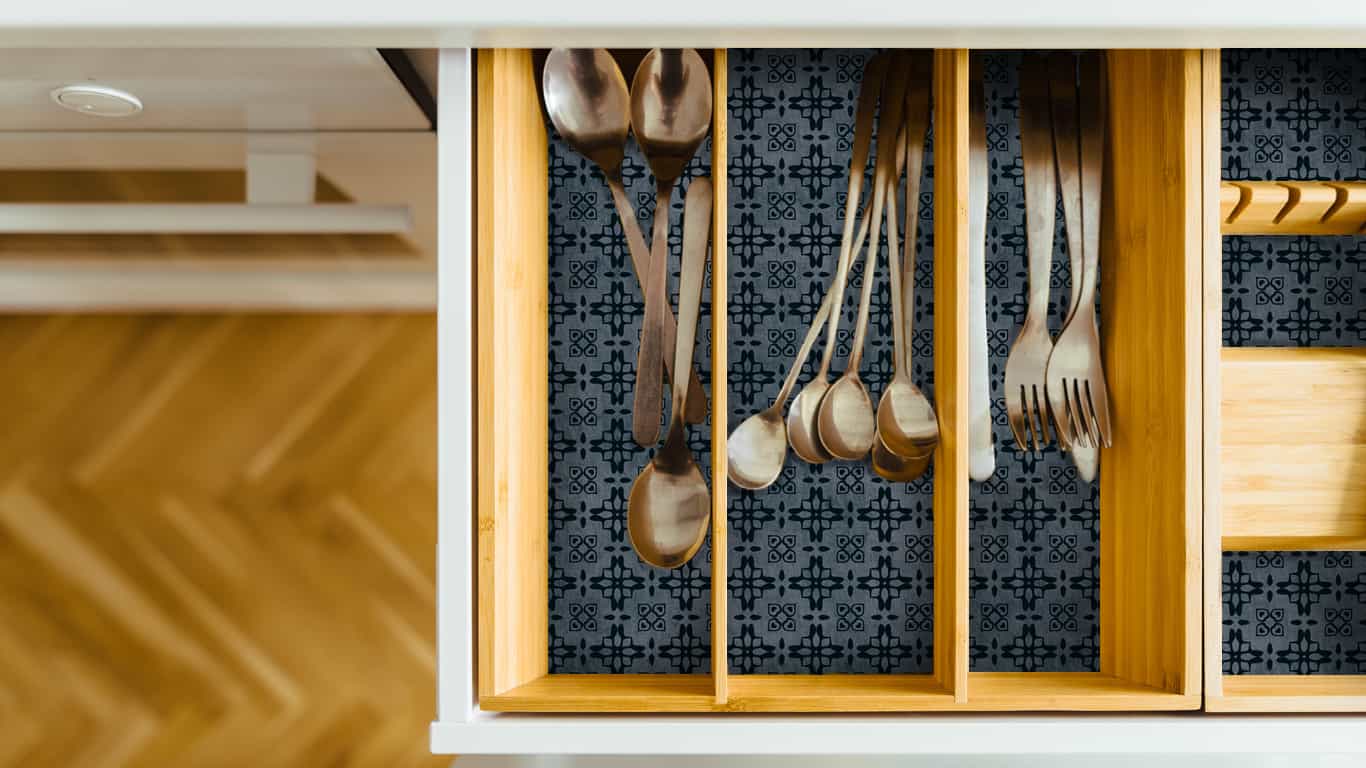How to Install Adhesive Contact Shelf Paper
Shelf paper is simple to install and with a little care, wonderful-looking results are simple to achieve. For first-timers, we recommend you start with a non-obvious surface (either a high or low shelf for example) to understand the installation technique. Remember, the backing is your friend, do not remove it until you’re ready to stick it down. If you don’t want to use adhesive contact paper or have questions, see which contact paper material to use. In the following instructions, we’ll guide you through our step-by-step process on how to properly install adhesive contact shelf paper and adhesive shelf liners.
Overview: Installing adhesive contact shelf paper
- Clean all surfaces
- Cut product to size (if necessary)
- Test fit and position product
- Expose a small strip of adhesive and secure material in place
- Remove the backing a little at a time
- Smooth the paper outwards starting from the center
- If the alignment moved, carefully lift and re-apply
Tools for installing adhesive contact shelf paper
- A putty knife
- A good commercial cleaner or TSP (Tri-Sodium Phosphate)
- Medium grit (150) sandpaper (optional)
- Low-tack masking tape
- Hand squeegee (shipped with applicable orders) or credit card
This process describes installation into a cabinet, but the steps are basically the same for free-hanging shelves, cubbies, furniture, drawers or most other surfaces.
Step 1: Prepare your surfaces
Preparation is the first step to a good job – the goal is to begin with a clean, flat surface. New cabinets should be thoroughly vacuumed, then gone over with a damp cloth. For older surfaces, remove any loose particles, dust, oil, wax, or other contaminants by cleaning with a good cleaner like TSP (available in the paint section of most hardware stores). Dry thoroughly before installing your new shelf paper. Note: Since we use a moderate tack adhesive, edges or corners will lift if the adhesive is contaminated with dirt or dust.
Step 2: Layout your adhesive contact paper for proper fitment
Fit the new liner on the shelf so it lays flat. (Unroll and place the new liners pattern side-up in sunlight for a few minutes if needed to make them more pliable.) For a large surface, you may want to use painter’s tape or a small weight to hold the liner in place. Our liners are trimmed slightly under dimensions for ease-of-fit, so they should lay flat on all corners without pushing up on any sides.
Step 3: Peel back a small strip of the backing of your adhesive contact paper
Expose a small strip of adhesive. Without disturbing the alignment, lift an edge of the liner and peel back a small 1/2″ – 1″ (12-25 mm) strip of the backing and crease it back onto itself so the adhesive is exposed. Replace the lifted edge of the liner with the contact area down.
Step 4: Apply pressure with a squeegee to apply exposed liner to surface
Check final alignment and then apply light pressure with your thumb or finger over the section with exposed adhesive. Use moderate pressure with the soft edge of the hand squeegee to gently smooth the contact area. Work only from the center towards the edges. This will ensure any trapped air bubbles are expressed. If an air bubble is trapped, lift the edge of the liner and move the air bubble to the perimeter with the squeegee.
Step 5: Continue to remove backing in small segments
Remove the backing in small segments. The contact area should hold quickly. Peel back the liner to expose a new area of adhesive. Originating from the center, use the squeegee to lay the liner flat using a front-to-back, back-to-front motion. Do not stretch the liner. Overlap strokes and always work from an adhered section. Continue until all the backing is removed.
Step 6: Work your way towards the edges to ensure adhesion of contact paper
Gently push the firm edge of the squeegee into the corners and around the perimeter to ensure good adhesion. If an air bubble is trapped, you can use a sewing needle or pin to lance the bubble, then smooth that area with the squeegee towards the pinhole.
Step 7: Repeat until complete
Repeat until complete. Then stand back to admire your handiwork, your awesome pattern choices, and how great your completed project looks!
Make sure to check out our FAQs to see more commonly asked questions, idea boards on Pinterest, or contact us with any concerns you may have.
